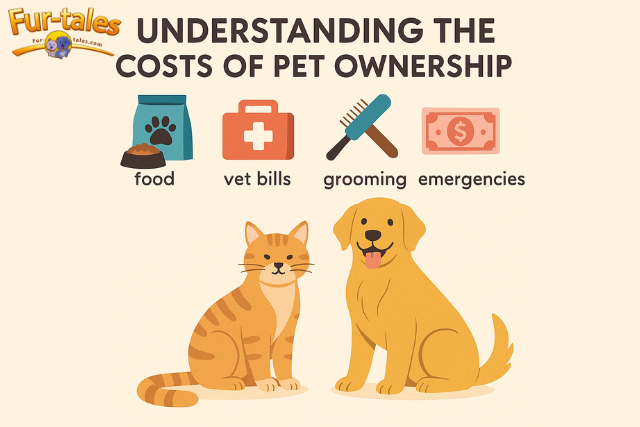
Understanding the Costs of Pet Ownership: A Comprehensive Guide
Bringing a pet into your life is a joyful and rewarding experience, but it’s also a significant financial commitment. Whether you’re considering adopting a playful puppy, a cuddly kitten, or a charming parrot, it’s essential to understand the true cost of pet ownership. These costs extend far beyond the initial adoption or purchase fee and include ongoing expenses that can last a decade or more.
This guide breaks down all aspects of pet-related expenses so you can make an informed decision that’s good for your lifestyle—and your wallet.
Initial Costs of Getting a Pet
When you first bring a pet home, there are a variety of one-time costs you’ll incur to ensure your pet’s safety, comfort, and health.
1. Adoption or Purchase Fee
- Adoption: Usually ranges from $50 to $300 depending on the shelter or rescue organization.
- Buying from a breeder: Can cost between $500 to $3,000 or more, especially for purebred dogs or exotic animals.
2. Initial Medical Exams
- Vaccinations, deworming, microchipping, and a wellness exam may cost $100 to $300.
3. Spay/Neuter Surgery
- Typically costs between $150 and $300, though some shelters include this in adoption fees.
4. Supplies
- Beds, collars, crates, toys, and food/water bowls can easily total $200 to $500 in the first few months.
Recurring Monthly Expenses
Once you’ve welcomed your new pet, you’ll face ongoing monthly or annual costs that can add up quickly.
1. Food
- Quality pet food is essential. Monthly costs vary:
- Cats: $20–$50
- Small Dogs: $20–$40
- Large Dogs: $50–$100+
- Birds/Rabbits: $10–$30
2. Veterinary Care
- Annual exams and vaccinations: $200–$300 per year
- Flea/tick/heartworm prevention: $30–$100 per month
- Dental cleanings: $200–$700 annually
3. Pet Insurance
- Pet insurance premiums vary by species, breed, and coverage but typically range between $30 and $70 per month. It can save thousands in the event of emergencies.
4. Grooming
- Costs depend on the breed and grooming needs.
- Cats and short-haired dogs: Occasional grooming
- Long-haired dogs or specialty breeds: Grooming can cost $40–$100 every 4–6 weeks
Hidden or Unexpected Expenses
Many pet owners underestimate the unexpected costs associated with their furry (or feathery) companions.
1. Emergency Vet Visits
- Unplanned medical visits can run from $500 to $3,000+, depending on the issue.
2. Pet Deposits and Rent
- Many landlords charge pet deposits ($200–$500) or monthly pet rent ($25–$50/month).
3. Pet Sitting or Boarding
- If you travel frequently, budget for pet care.
- Pet boarding: $25–$75 per day
- Professional pet sitters: $15–$40 per visit
4. Training and Behavior Support
- Group classes cost $100–$300 for a 6–8 week course.
- Private trainers may charge $50–$150 per session.
Comparing Pet Types: Cost Overview
Here’s a simplified comparison of average annual costs for popular types of pets:
| Pet Type | Initial Cost | Annual Cost |
|---|---|---|
| Dog (Medium) | $500–$1,000 | $1,000–$2,500 |
| Cat | $400–$800 | $700–$1,500 |
| Rabbit | $200–$400 | $500–$1,000 |
| Bird (Parrot) | $300–$1,000 | $400–$1,200 |
| Fish (Tank) | $150–$500 | $100–$300 |
Note: These are general ranges; actual costs can vary significantly depending on breed, size, and region.
Budgeting for the Long-Term
Pets are a 10 to 20-year commitment. Budgeting for the long haul is vital to providing your pet with the best possible life.
1. Create an Emergency Fund
Set aside a dedicated emergency fund of at least $1,000–$2,000 for vet emergencies or unexpected issues.
2. Use Subscription Services
Many pet food brands, medication providers, and toy boxes offer subscription models, which can save time and money.
3. Consider Pet Insurance
Pet insurance may seem like an extra monthly expense, but it can pay off during emergencies. Some policies even cover routine care.
Reducing Pet Ownership Costs Without Sacrificing Care
You don’t need to compromise your pet’s well-being to manage costs effectively. Here are some budget-friendly tips:
- Adopt, don’t shop: Shelters often include vaccinations and spay/neuter in adoption fees.
- Buy in bulk: Food, litter, and treats are cheaper in larger quantities.
- DIY grooming: With the right tools, basic grooming can be done at home.
- Pet wellness plans: Some vets offer plans that include annual exams, vaccines, and discounts on services.
- Use cashback or reward apps: Earn cashback on pet supply purchases through apps like Rakuten or Fetch.
FAQs: Understanding Pet Ownership Costs
Q: What is the most expensive part of pet ownership?
A: Veterinary care, especially emergencies or chronic illnesses, tends to be the highest unexpected cost.
Q: Is pet insurance worth it?
A: Yes, particularly if you have a breed prone to health issues. It can help offset large vet bills.
Q: How can I prepare financially before adopting a pet?
A: Research breed-specific costs, create a monthly budget, and start an emergency fund in advance.
Q: Are some pets cheaper to care for than others?
A: Generally, small animals like fish, hamsters, or rabbits have lower ongoing costs compared to dogs or cats.
Q: Can I afford a pet on a tight budget?
A: Yes, with careful planning and prioritizing essentials, pet ownership is possible—but avoid cutting corners on health and nutrition.
Conclusion: The Real Price of Love
Owning a pet brings unconditional love, companionship, and joy—but also responsibility. Understanding the full scope of pet ownership costs helps you prepare for the road ahead and ensures your pet receives the care they deserve.
Before bringing a new animal into your home, evaluate your finances, lifestyle, and long-term ability to provide. With thoughtful budgeting and a bit of planning, pet ownership can be one of the most rewarding investments you’ll ever make.
Image Designed Using Canva
